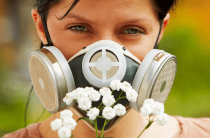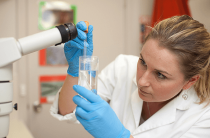For many, a good tan is the main joy they want from the summer season. In addition, the sun's rays are of great benefit to the body, participating in the production of vitamin D. But also, the sun can be aggressive towards our skin and can cause burns, allergic reactions, tumors.
The first manifestations of allergy to the sun can be found already in early May. The rays of the sun, in themselves, cannot be an allergen, since allergens penetrate deep into the body, and the rays act only on the surface. The sensitivity of the body, in humans in this case, occurs in response to the production of certain substances that are formed in the cells of the epidermis after exposure to sunlight on the skin. Such a disorder may accompany certain diseases. So, if suddenly you have it for no reason, this should be a wake-up call for you.
The kidneys, liver and adrenal glands are the organs whose malfunction can provoke the development of this disease. Also, the pigmentation features of some people provoke such a reaction to sunlight.
Types of sun allergies
solar injury
This type of skin reaction is very common. Actually, it does not refer to allergic, but to traumatic disorders. You don't have to be allergic to get this disease. It often occurs in people who do not adhere to the correct approach to the organization of exposure to direct sunlight. A long stay under open rays, in the hourly interval from 11:00 to 16:00, is dangerous for any person. Especially if they are accompanied by immersion in water, small droplets of which act like a lens, amplifying the radiation.
Toxic reactions
In this case, the signs of sun allergy are mediated by the influence of certain substances that increase the skin's susceptibility to ultraviolet radiation. Certain plants, medicines and a number of other factors can provoke an increase in skin sensitivity.
Photodermatitis
Actually, this is an allergy to the sun. In this case, the occurrence of allergic reactions on the skin is directly related to the work of the immune system, which is hostile to substances formed in the skin tissue under the influence of sunlight.
The risk group includes:
- people suffering from endocrine diseases;
- people suffering from kidney and liver diseases;
- women in a state of pregnancy;
- people with light skin type;
- people who have allergies in their family;
- children under 6 years of age.
Sun allergy symptoms
Photodermatitis is a skin disease that is characterized by corresponding manifestations. The rate of development of symptoms can vary, from several tens of minutes to several days.
 Areas of the skin, after contact with ultraviolet light, become reddish, rashes and areas of abscesses form on them. The epidermis on the extremities acquires a rough texture, itching and severe burning may occur at the sites of manifestation of an allergic reaction. The skin becomes rough, local bleeding may appear
Areas of the skin, after contact with ultraviolet light, become reddish, rashes and areas of abscesses form on them. The epidermis on the extremities acquires a rough texture, itching and severe burning may occur at the sites of manifestation of an allergic reaction. The skin becomes rough, local bleeding may appear
The face of a patient with photodermatitis may be strewn with white spots that appear due to a failure in the pigmentation processes. Prolonged exposure to intense ultraviolet radiation causes the body to spend all its energy on the production of special pigments that lead to darkening of the skin. Such emergency activity leads to the fact that the body is subjected to intense stress.
In most cases, already after a few hours in direct sunlight, people with a tendency to this disease begin its first manifestations. Often the symptoms are urticaria, which is the appearance of red spots that are slightly raised and warm to the touch. Blisters filled with a clear liquid may also appear at the point of contact. This is a sure sign that a person has a sunburn.
Causes of Sun Allergies
- Antibacterial components of hygiene products;
- Essential oils, which are often used in the manufacture of cosmetics and perfumes;
- Piercings and tattoos can increase skin sensitivity at the sites of their application;
- Benzophenones and para-aminobenzoic acid, which are often found in sunscreens, increase the skin's sensitivity to sunlight in some people;
- Light skin type;
- Pregnancy and children under 6 years of age.
sun allergy cure
Treatment of photodermatitis
The main ways that modern medicine offers to avoid sun allergies are:
- Removal of local symptoms in photodermatitis, on the surface of the epidermis with special ointments, creams and gels
- General treatment with drugs in the form of tablets and injections
- Preventive measures
 Naturally, the last way is the most effective and safe. To avoid this disease, it will be sufficient just to follow a few rules: eliminate the factors that provoke an allergy to the sun and not be in direct sunlight during the daytime. In most people, the epidermis only reacts to extremely intense solar radiation, so following these simple instructions will allow you to avoid the problems that are provoked by this most unpleasant disorder.
Naturally, the last way is the most effective and safe. To avoid this disease, it will be sufficient just to follow a few rules: eliminate the factors that provoke an allergy to the sun and not be in direct sunlight during the daytime. In most people, the epidermis only reacts to extremely intense solar radiation, so following these simple instructions will allow you to avoid the problems that are provoked by this most unpleasant disorder.
Local therapy for sun allergy
This type of therapy for photodermatitis is of great importance, since the main symptoms of this disease are localized on the skin. In order to eliminate these manifestations, special medicines are used, in the form of creams, ointments and gels for application to the skin. Their use allows you to remove puffiness, accelerate the process of regeneration of damaged surfaces, eliminate itching, and relieve skin irritation.
Hormonal medications
These drugs contain the hormone cortisol, or its analogues, which is why they are called hormonal. Medicines of this group are highly effective in the treatment of skin manifestations of allergies. A large number of possible side effects makes one more careful about their use.
Proper use of hormonal ointments:
- hormonal topical drugs can be used only if the allergic nature of skin manifestations is confirmed;
- these funds are not used as prophylactic and are intended only to eliminate already existing symptoms;
- hormonal ointments are divided according to the strength of action. The choice of ointment should occur, taking into account the severity of allergic manifestations;
- if the child is less than six months old, then the use of fluoride-containing ointments is unacceptable;
- long-acting ointments, it is desirable to prefer a form with a short therapeutic effect;
- at the same time, corticosteroid drugs are not applied to more than 20% of the skin;
- after a week, the effect of the treatment should be expressed, otherwise, it undergoes a change;
- used only on clean skin.
Side effects are an extremely relevant topic when using this type of drug. Often, they appear in the case of improper use, which patients allow for self-use. Also, the intensity and degree of risk of the relevance of side effects directly depends on the strength of the hormonal drug. The most powerful ointments based on corticosteroids of the 4th category.
Local immunity of the skin often becomes a victim of drug therapy, of hormonal origin. It is due to the suppression of local immunity that the skin allergic reaction is eliminated. The suppression of local immunity is fraught with the appearance of skin infections that were in an inactive form.
Classification of hormonal ointments used to treat sun allergies:
| drug category | Effect | denominations |
| 1st | the weakest of all local corticosteroids, which is associated with low absorption of active substances into the skin. | prednisolone and hydrocortisone ointments |
| 2nd | average activity, which is combined with average assimilation rates. | afloderm, lorinden, zinocort, locarotene, prednicarbate |
| 3rd | the therapeutic effect comes quickly, a good coefficient of assimilation. | elocom, apulein, cutiveit, flucort, fluorocinoid, polcortolone |
| 4th | the strongest therapeutic effect, as well as the maximum coefficient of assimilation. | dermovate, chalciderm, galcinonide |
With allergies to the sun, hormonal ointments are prescribed in the following cases:
- allergic processes on the surface of the skin of an acute nature (solar urticaria, dermatitis);
- treatment with drugs of a weaker class does not bring the desired effect;
- there are reasonable fears for the development of eczema;
- the disease has the character of relapse;
- complications, in the form of neurodermatitis.
Side effects of hormonal ointments
With an allergy to the sun, which has a skin manifestation, the frequent use of hormonal ointments leads to the fact that the issue of side effects is very acute. Modern therapeutic practice, the use of hormonal ointments, with photodermatitis has optimal treatment regimens that allow you to avoid side effects. Often, a negative impact on health occurs in the case of independent use.
However, it is impossible to completely avoid the risk of side effects of the drug! When using hormonal medicines, in the form of ointments, they include the following:
- irritation and itching at the site of application;
- exacerbation of a local fungal or viral infection;
- the appearance of boils;
- acne;
- atrophic skin changes;
- coarsening of the skin.
When using these drugs, it is worth considering that the degree of their activity in relation to the elimination of skin manifestations of allergies is directly proportional to the degree of their activity. The more powerful the effect they have, the more pronounced their side effect.
Antihistamine ointments for sun allergies
Topical antihistamines contain substances that prevent the effects of histamine on skin cells. When the hormone histamine is released, under the influence of allergens, allergy symptoms develop. This provokes the appearance of rashes, itching, swelling. The advantage of antihistamines in the form of ointments helps to eliminate the skin manifestations of allergies with a minimal risk of developing common side effects. These include those side effects that affect the action of the whole body.
Effects of antihistamine ointments:
- reduce itching, irritation and overdrying of the skin;
- contribute to the narrowing of local blood vessels, which expand under the action of histamine;
- elimination of symptoms of dermatitis and urticaria;
- promotes hydration;
- accelerates skin healing;
- development of a therapeutic effect from 15 to 30 minutes.
Healing and anti-inflammatory drugs
In the treatment of allergies to the sun, these drugs can also be involved. In this case, they do not affect the mechanisms of allergic reactions, but on specific symptoms that appear with an allergy to the sun: inflammation, dry skin, local irritation, pain.
Nurofen (ointment) is a medicine whose main active ingredient is an anti-inflammatory drug based on ibuprofen. Ibuprofen is a non-steroidal drug. In addition, the use of an ointment based on ibuprofen can relieve the pain that often accompanies the skin manifestations of photodermatitis. At the same time, there is no risk of damage to the mucous membrane of the gastrointestinal tract, which is present when using ibuprofen in the form of tablets.
Diclofenac (ointment) is a medicine belonging to the category of non-steroidal anti-inflammatory drugs. Active ingredient: sodium diclofenac. Its action is based on the suppression of the production of prostaglanid proteins. The use of diclofenac allows you to remove skin swelling, pain, irritation, and also relieves local fever, in places of an allergic reaction. With urticaria, bronchial asthma, as well as in the case of peptic ulcers, this remedy is not used.
Bepantent (panthenol) is a safe drug that is based on the action of a derivative of vitamin B group. Passing through a series of biological transformations inside the skin, the active substance of the drug turns into dexpanthenol. It takes part in the regeneration of skin cells. Its use is relevant for allergies to the sun, both in the case of directly allergic reactions, and in the case of sunburn. Medicines based on panthenol promotes healing of the skin, as well as their hydration.
sun allergy pills
Medicines in the form of tablets, with allergies to the sun, may also be applicable, in some cases. This happens at the discretion of the doctor. Antihistamines are drugs that block type 1 histamine receptors. They are on the surface of the skin. Upon contact with them, skin manifestations of photodermatitis occur. Medicines containing antihistamines can eliminate the formation of edema, reduce skin itching, and reduce the expansion of blood vessels.
Diphenhydramine is one of the first antihistamines to enter the market. It well eliminates skin manifestations of allergies, reduces itching and inflammation. However, this drug has a number of side effects: it dries up the mucous membrane, retains urine, and also causes inhibition of the central nervous system. The latter, during therapy with diphenhydramine, is most acute. Under its influence, drowsiness, fatigue develops, and the thought process slows down. One of the main advantages of this drug is its low cost.
Diazolin is also a very outdated drug. The main advantage is the low cost, as well as the low probability of developing an inhibitory effect. A significant disadvantage of this drug is the ability of the active substance to irritate the mucous membranes of the stomach, in some patients. For this reason, it is not used in the treatment of patients who have peptic ulcers and gastritis.
Suprastin is an effective drug that is most often used in the treatment of allergic diseases. In particular, this applies to allergies to the sun. It has a rapid development of a therapeutic effect, which also quickly decreases. The drug does not have a cumulative effect, so it is often used for long-term therapy.















